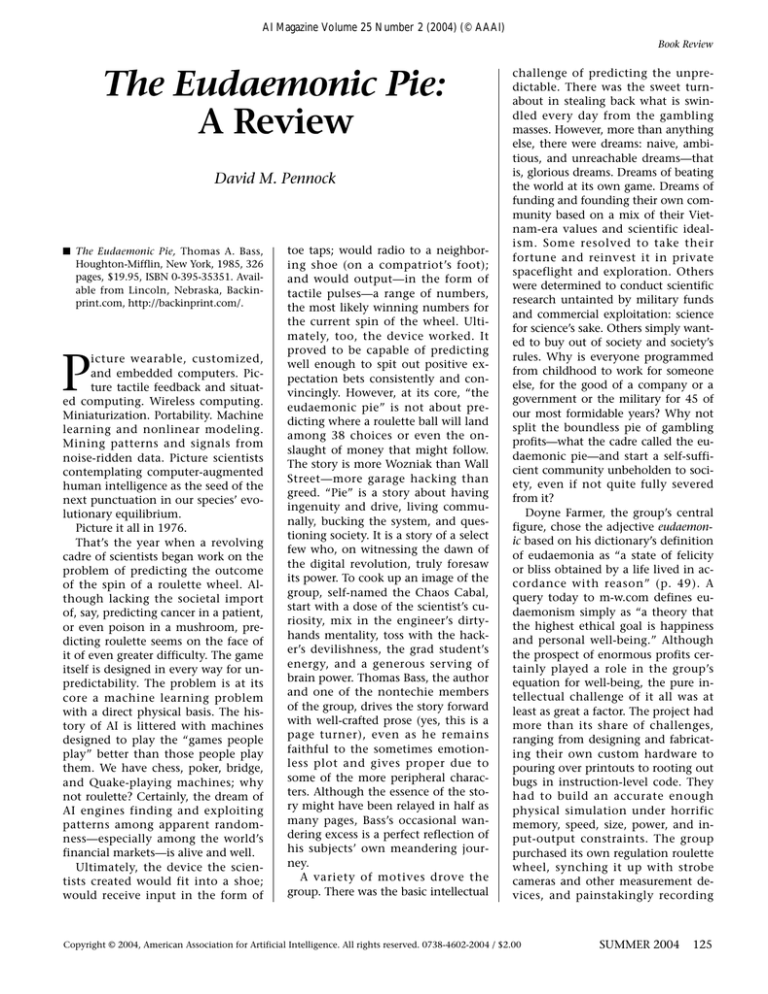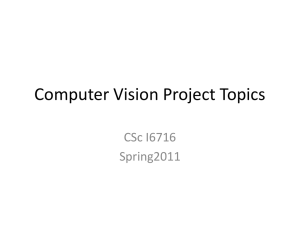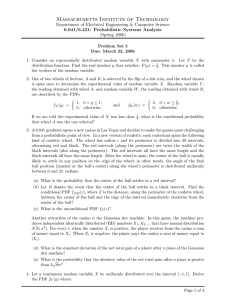toe taps; would radio to a neighbor-
advertisement

AI Magazine Volume 25 Number 2 (2004) (© AAAI) Book Review The Eudaemonic Pie: A Review David M. Pennock ■ The Eudaemonic Pie, Thomas A. Bass, Houghton-Mifflin, New York, 1985, 326 pages, $19.95, ISBN 0-395-35351. Available from Lincoln, Nebraska, Backinprint.com, http://backinprint.com/. P icture wearable, customized, and embedded computers. Picture tactile feedback and situated computing. Wireless computing. Miniaturization. Portability. Machine learning and nonlinear modeling. Mining patterns and signals from noise-ridden data. Picture scientists contemplating computer-augmented human intelligence as the seed of the next punctuation in our species’ evolutionary equilibrium. Picture it all in 1976. That’s the year when a revolving cadre of scientists began work on the problem of predicting the outcome of the spin of a roulette wheel. Although lacking the societal import of, say, predicting cancer in a patient, or even poison in a mushroom, predicting roulette seems on the face of it of even greater difficulty. The game itself is designed in every way for unpredictability. The problem is at its core a machine learning problem with a direct physical basis. The history of AI is littered with machines designed to play the “games people play” better than those people play them. We have chess, poker, bridge, and Quake-playing machines; why not roulette? Certainly, the dream of AI engines finding and exploiting patterns among apparent randomness—especially among the world’s financial markets—is alive and well. Ultimately, the device the scientists created would fit into a shoe; would receive input in the form of toe taps; would radio to a neighboring shoe (on a compatriot’s foot); and would output—in the form of tactile pulses—a range of numbers, the most likely winning numbers for the current spin of the wheel. Ultimately, too, the device worked. It proved to be capable of predicting well enough to spit out positive expectation bets consistently and convincingly. However, at its core, “the eudaemonic pie” is not about predicting where a roulette ball will land among 38 choices or even the onslaught of money that might follow. The story is more Wozniak than Wall Street—more garage hacking than greed. “Pie” is a story about having ingenuity and drive, living communally, bucking the system, and questioning society. It is a story of a select few who, on witnessing the dawn of the digital revolution, truly foresaw its power. To cook up an image of the group, self-named the Chaos Cabal, start with a dose of the scientist’s curiosity, mix in the engineer’s dirtyhands mentality, toss with the hacker’s devilishness, the grad student’s energy, and a generous serving of brain power. Thomas Bass, the author and one of the nontechie members of the group, drives the story forward with well-crafted prose (yes, this is a page turner), even as he remains faithful to the sometimes emotionless plot and gives proper due to some of the more peripheral characters. Although the essence of the story might have been relayed in half as many pages, Bass’s occasional wandering excess is a perfect reflection of his subjects’ own meandering journey. A variety of motives drove the group. There was the basic intellectual challenge of predicting the unpredictable. There was the sweet turnabout in stealing back what is swindled every day from the gambling masses. However, more than anything else, there were dreams: naive, ambitious, and unreachable dreams—that is, glorious dreams. Dreams of beating the world at its own game. Dreams of funding and founding their own community based on a mix of their Vietnam-era values and scientific idealism. Some resolved to take their fortune and reinvest it in private spaceflight and exploration. Others were determined to conduct scientific research untainted by military funds and commercial exploitation: science for science’s sake. Others simply wanted to buy out of society and society’s rules. Why is everyone programmed from childhood to work for someone else, for the good of a company or a government or the military for 45 of our most formidable years? Why not split the boundless pie of gambling profits—what the cadre called the eudaemonic pie—and start a self-sufficient community unbeholden to society, even if not quite fully severed from it? Doyne Farmer, the group’s central figure, chose the adjective eudaemonic based on his dictionary’s definition of eudaemonia as “a state of felicity or bliss obtained by a life lived in accordance with reason” (p. 49). A query today to m-w.com defines eudaemonism simply as “a theory that the highest ethical goal is happiness and personal well-being.” Although the prospect of enormous profits certainly played a role in the group’s equation for well-being, the pure intellectual challenge of it all was at least as great a factor. The project had more than its share of challenges, ranging from designing and fabricating their own custom hardware to pouring over printouts to rooting out bugs in instruction-level code. They had to build an accurate enough physical simulation under horrific memory, speed, size, power, and input-output constraints. The group purchased its own regulation roulette wheel, synching it up with strobe cameras and other measurement devices, and painstakingly recording Copyright © 2004, American Association for Artificial Intelligence. All rights reserved. 0738-4602-2004 / $2.00 SUMMER 2004 125 Book Review predictions and outcomes by hand for experimental verification and statistical validation. The blissful drudgery of testing included learning to time their toe taps with key moments of the spin and memorizing the intricacies of how consecutive numbers on the wheel are distributed in various places across the betting table layout. If the computer pinpoints the upper-left quadrant of the wheel, for example, the bettor must decode the corresponding strategy for placing chips on numbers spread far and wide across the table. The Challenge of Roulette A roulette ball is set in motion by the toss of the croupier, a casino employee, who sends the ball spinning around a wheel a few dozen times or so. As the ball’s momentum dies, it bounces off the opposite-spinning rotor several times before settling in a particular numbered slot, one of 38 possible landing points. Because the payoff to the bettor for choosing the winning number is only 36 to 1, the casinos seem to have designed a foolproof (long-run) money pump. However, there is one exploitable flaw for the crafty gambler turned investor, ironically exposed by the casinos themselves. The casinos allow betting to continue for a time, even after the croupier sets the ball spinning. It’s during this brief window that the Chaos Cabal went to work, tapping into their shoe computer various observations about the relative positions and velocities of the ball and rotor (other information such as the tilt of the wheel had already been entered), letting their computer chug away at inducing a (hopefully accurate and nonuniform) probability distribution over the ball’s trajectory. However, even given this tiny window of opportunity, the problem seems almost intractable: The fate of the ball seems the very definition of “sensitive dependence on initial conditions.” Any extra oomph applied by the croupier in his/her initial throw of the ball, any variations in temperature, humidity, or wheel alignment, any flap of a butterfly’s wings near the poker table across the 126 AI MAGAZINE room, seem destined to perturb the ball’s path enough that after a few randomizing bounces, the ball should go sputtering into an entirely unpredictable new numbered slot. However, the Cabal showed this intuition to be incorrect: Roulette balls apparently aren’t so fazed by butterflies flapping, among other incidental forces. Ironically, some of the same scientists were—at their day jobs—busy changing the face of physics with notions that complex systems such as the weather are indeed extremely dependent on tiny long-range perturbations such as butterflies flapping in China; they were trailblazers in the new (at the time) science of chaos and nonlinear dynamics, hence their moniker as the Chaos Cabal. Highprofile members of the group included Doyne Farmer, Jim Crutchfield, and Norman Packard, three of the scientists instrumental in hatching the Los Alamos National Laboratory Center for Nonlinear Studies, and later the Santa Fe Institute for the Study of Complex Systems, which would go on to attract a wealth of intellectuals, including Nobel laureates and MacArthur grant recipients. Although their burgeoning chaos theory was dashing the dreams of meteorologists everywhere, the Cabal’s roulette prediction algorithm was proving remarkably accurate. They concluded that their algorithm’s forecasting power was enough to overcome the casino’s tax on entertainment, transforming a money-sucking 5-percent casino edge into a staggering 44-percent moneyminting player edge! Thus, although wild swings are certainly possible, even inevitable, on average over time, in the long-enough long run, every $1 invested yields $1.44 in return. With a high enough initial investment, and compounded minute by minute at the blistering pace of roulette (after all, the casinos want to keep things moving, trying their best to work their own compounding magic), the potential gains are unimaginable. Let’s just say that an investor with access to a 44-percent roulette edge on the one hand and the profits from a $500,000 loan on the other might consider the loan profits to be little more than roundoff error. Although everything described here is mostly legal (speak with counsel before attempting), one barrier remains to achieving such nearly boundless profits: Casinos don’t like it. Casinos don’t let you haul computers onto the casino floor to help you beat them at their own game. Even if you successfully hide your prediction device—something a bit easier today than in 1976—if you simply win too much for whatever reason (maybe you’re just a couple of standard deviations too lucky), you might find yourself barred for life from the casino at best or taken to a back room for a stern “scare session” at worst. (The days of serious physical threats are apparently over.) The Cabal’s need for stealth led to a variety of engineering nightmares, not the least of which was the miniaturization and customization required to fit all the necessary components into a pair of shoes. Their choice to use two people—one as the data enterer and the other as the bettor—meant that their respective shoes needed facilities and protocols for wireless communication. Actuators hidden under the bettor’s sweatshirt, wired to his/her shoe computer and designed to deliver betting instructions, at times caused painful shocks as the bettor sweat prodigiously in the heat of casino action. Parts that worked seamlessly in the lab failed in unpredictable ways in the casino, for example, as interference from the circuitry of the battalion of cameras forming the so-called “eyes in the sky” interfered with their own wireless transmissions. The project spanned several years, with a handful of modestly successful “field trips” to Lake Tahoe, Reno, and Las Vegas, interspersed with countless hours of testing and tweaking in the lab. The slow pace was the result in part of the project’s complexity, in part as membership shuffled, in part as key members pursued legitimate —in some cases, stellar—academic careers in parallel, and in part as the pursuit of perfection and aesthetic beauty began to trump practicality. After some success with a first prototype, renewed creative energy from a Book Review Imitation of Life How Biology Is Inspiring Computing Nancy Forbes “This book will appeal to technophiles, interdisciplinarians, and broad thinkers of all stripes.” — George M. Church, Harvard Medical School 176 pp., 48 illus. $25.95 cloth Models of a Man New from The MIT Press Introduction to Autonomous Mobile Robots Roland Siegwart and Illah R. Nourbakhsh “Easy to read and well organized. . . . both the beginner and the advanced student will have a clear idea of how a robot can be endowed with mobility.” — Raja Chatila, LAAS - CNRS, France Essays in Memory of Herbert A. Simon edited by Mie Augier and James G. March Intelligent Robotics and Autonomous Agents series A Bradford Book • 331 pp., 182 illus. $50 Essays that pay tribute to the wide-ranging influence of the late Herbert Simon, by friends and colleagues. Ant Colony Optimization 584 pp., 20 illus. $45.95 now in paperback The Geometry of Multiple Images The Laws That Govern the Formation of Multiple Images of a Scene and Some of Their Applications Olivier Faugeras and Quang-Tuan Luong with contributions from Theo Papadopoulo “This is a novel, well-written, thorough presentation of a topic of clear interest in the computer vision field.” — Eric Grimson, MIT 672 pp., 230 illus. $35 paper To order call 800-405-1619. Marco Dorigo and Thomas Stützle “Essential reading not only for those working in artificial intelligence and optimization, but for all of us who find the interface between biology and technology fascinating.” — Iain D. Couzin, Princeton University, and University of Oxford A Bradford Book • 328 pp., 72 illus. $40 now in paperback Evolutionary Robotics The Biology, Intelligence, and Technology of Self-Organizing Machines Stefano Nolfi and Dario Floreano “Will be an important reference for experimental and theoretical studies in evolutionary robotics for quite some time.” — AI Magazine Intelligent Robotics and Autonomous Agents series A Bradford Book • 336 pp., 157 illus. $28 paper http://mitpress.mit.edu new member sparked a complete redesign of the system. The redesign was in all respects a beautiful feat of engineering, although when measured according to a yardstick of profits, performed hardly any better. Beating the System A certain cult industry exists touting schemes to beat every sort of gambling game. Most systems are less about profits than about dreams, schemes, and publishing royalties. Still, a few strategies stand up better to scientific scrutiny. The most storied and publicized—touched off by the enormous success of Edward Thorpe’s 1962 book Beat the Dealer—involve blackjack and counting cards. A new book—and soon a movie—called Bringing Down the House by Ben Mezrich, claims to tell the true story of how a shadowy organization called the MIT Blackjack Team raked in millions executing stealth attacks on Vegas.1 Other games, such as poker and sports wagering, are beatable if a player is significantly smarter than average. Naturally, more than half of the people believe they are the smart ones. Steven Skiena’s Calculated Bets is an irreverent account of a computer science professor dabbling in automated jai alai betting, written for the broadest of broad audiences, yet entertaining nonetheless. In a book called Efficiency of Racetrack Betting Markets, professional gambler Bill Benter describes a winning horse race betting system that reportedly earned millions annually beating the tracks in Hong Kong.2 Financial markets offer the biggest gambling game of all. Two of the Chaos Cabal—Farmer and Packard— went on to form a beat-the-market company called the Prediction Company, recounted in The Predictors, also by Thomas Bass. Thorpe himself eventually moved on from blackjack to the big leagues of Wall Street. It is in finance that AI has the longest tra- dition. From neural networks to Bayesian networks, countless AI methods have been tasked with unearthing predictability among the mysteries of market fluctuations. The Cabal’s accomplishments are especially impressive given the state of hardware and software at the time. Today, miniaturization, wireless communication, and computational power are no longer the primary barriers. A hidden camera could snap consecutive pictures of the wheel as it spins, transmit data wirelessly to a palmtop computer with a vision subsystem to parse the images, compute the ball and wheel’s trajectory, and encode output as vibrations. (Any angel investors out there ready to start a company?) Still, even today, computational attacks on Vegas pose tough AI challenges, including visual segmentation and tracking of the wheel (or cards on a blackjack table, for that matter) and nonlinear prediction. That the Cabal tackled so many issues nearly three decades ago highlights SUMMER 2004 127 Book Review AAAI Fall Symposium Series Crystal City, Virginia 21–24 October 2004 Sponsored by the American Association for Artificial Intelligence www.aaai.org/Symposia/Fall/2004/ just how far we’ve come technologically—or at least how far Moore's Law has taken us—while simultaneously underscoring how little we've progressed in terms of key design insights, algorithms, and goals. Notes 1. See www.wired.com/wired/archive/ 10.09/vegas.htm. 2. See www.wired.com/wired/archive/10.03/betting.html. 128 AI MAGAZINE David M. Pennock is a senior research scientist at Yahoo! Research Labs based in Pasadena, California. He received a B.S. in physics from Duke University, an M.S. in computer science from Duke, and a Ph.D. in computer science from the University of Michigan. He has written over 35 publications, presented 20 talks, and applied for three patents relating to computational issues in electronic commerce and the World Wide Web. His research interests include information markets, e-market analysis, auctions, web analysis and modeling, recommender systems, machine learning, and AI. His research has received significant attention among e-market companies and in the media, including reports in Discover, New Scientist, the New York Times, E!Online, and CNN/Money. His email address is dp@nnock.com.



